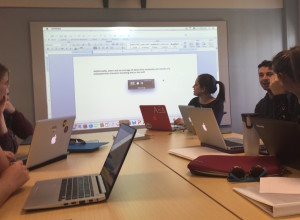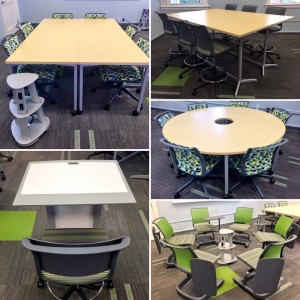Learning Spaces Workgroup creates new “active” classroom
Students and faculty who frequent Alamance have probably noticed that room 207 recently got a makeover. Outfitted with multiple projectors, rolling desks, and bar height tables, this classroom is now the picture of an innovative learning space. Indeed, Alamance 207’s revamp is part of a larger effort at Elon to build more “active” learning environments.
What’s an “active” learning space?
In the last few years, experts in higher education have started to reexamine how the design of learning spaces influences student engagement. Many institutions are moving away from traditional lecture-style classrooms and creating “active” learning environments that are more conducive to group work and provide access to a wider array of technologies. As a result, there’s a growing national discourse about implementing and assessing the impacts of innovative learning spaces.
Elon joined this conversation two years ago when a handful of faculty and staff established a Learning Spaces Workgroup. Members of the workgroup gather to confer on learning spaces at Elon. By connecting representatives from a variety of departments (from the registrar’s office to planning, design and construction to campus technology) the workgroup engages in conversations about learning space design, and ways in which faculty can be supported in using these spaces.
New and improved room 207
Alamance 207 is the result of the collaborative work of the Learning Spaces Workgroup, many conversations with faculty about the ideal learning environment, and the support of the Elon community. Over Winter Term, four projectors were installed (see right), which can display four different images simultaneously—with sound. What’s more, using AirMedia, students and professors can wirelessly stream content from their laptops directly onto the screens.
The classroom holds twenty-four seats for students, including rolling desks, seats at sectional tables, and chairs at bar height tables. Each piece of furniture was deliberately selected to help create an active learning environment.
The room’s mobile furniture can easily be rearranged to create different classroom setups that accommodate lectures and small group work. And wherever a student is sitting, an outlet is never too far away—mobile Power Towers (equipped with both standard outlets and USB ports) throughout the classroom allow students to recharge their devices whenever necessary.
207 as a case study
So, Alamance 207’s overhaul is pretty awesome. The classroom also has multiple writing surfaces, supporting Elon’s focus on writing. A number of faculty are currently teaching in this space, and the Learning Spaces Workgroup is evaluating how the classroom’s features affect student learning.
The workgroup is collecting data on Alamance 207 by keeping in touch with professors who teach in the room and surveying students. Over the course of this semester, they will issue three formalized assessments to students, asking what they think about the room, how it compares to other classrooms they’ve used at Elon, and what aspects of the room contribute to or detract from their learning.
The verdict (so far)
Overall, the response to 207’s new features has been really positive. Initial feedback from the faculty has been valuable to the Learning Spaces Workgroup as they consider the classroom of the future.
Read more about Elon’s contribution to the national conversation about innovative learning spaces here.



 Follow
Follow

